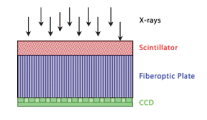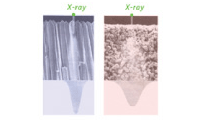Features of the Bio-Ray SDX Digital X-Ray System:
The Bio-Ray SDX size 2 sensor
Needle Structure Scintillator:
The purpose of the scintillator is to convert x-rays to light rays. A needle structure scintillator helps to focus the photons in a straight, downward fashion, eliminating unwanted scatter. Most companies use a granular structure scintillator, which generates scatter and noise.
Fiber Optic Plate:
The fiber optic plate improves image quality by stopping non-converted x-rays from interacting directly with the CCD, which in return eliminates unwanted noise in the signal. It also helps to focus the photons and apply them to the CCD in an even/consistent fashion.
CCD:
A unique manufacturing process enables us to provide a CCD with little or no blemishes. This nearly flawless CCD requires no correction file, which drastically improves hardware performance. (A correction file is software that is needed to fix defects in the hardware). With no correction file your sensor will be ready instantly, and more importantly you won’t have to worry about your sensor timing out during the capture process. Eliminating the need for a correction file also improves workflow with multiple sensors.
Resolution and Quality:
By utilizing a unique manufacturing process combined with the ideal materials for dental CCD imaging, and one of the smallest pixel sizes available, Bio-Ray SDX offers superior resolution and image quality. Sigma Digital X-ray combines superior hardware, software, and service, making the Bio-Ray SDX the best Intraoral Digital Radiography System available.
Schematic of a Scintillator-CCD Detector

Schematic of a Scintillator-CCD Detector. Incident X-ray photons interact with the scintillator where they are absorbed and light photons are emitted. Light photons enter the fiber optic plate and are carried to the CCD where they are detected and converted to electrons. |
Comparison between a needle and granular scintillator material

These illustrations show the emission spectra, decay, and X-ray absorption coefficient characteristics between the needle and granular scintillator materials. The Bio-Ray SDX uses a needle structure scintillator, as seen here on the left. This comparison clearly shows how the needle structure scintillator eliminates unwanted scatter. |
| Intraoral Sensor Specifications: |
| Sensor Size: |
Size 1 |
Size 2 |
| Pixels in Sensor |
1.50 |
2.04 |
| Pixel Size: |
20 x 20 |
20 x 20 |
| Active Image Area(mm): |
30 x 20 |
4 x 24 |
| Resolution: |
25 |
25 |
| External Dimensions(mm) |
38.5 x 26.2 |
42.5 x 30.5 |
Bio-Ray Intraoral Digital Radiography
System Includes:
- Bio-Ray SDX Sensor
- Bio-Ray SDX USB Interface
- Single User Imaging Software
- Sensor Positioning System
- Sensor Sheaths
|
Advantage of using the Bio-Ray System:
- Exceptional Customer Support and Reliability
- Affordable Price
- Exceptional Quality Eliminates Downtime
- Detailed and Consistent Images
- Bridges with Virtually all Practice Management Software
|
Contact Us For Pricing |

